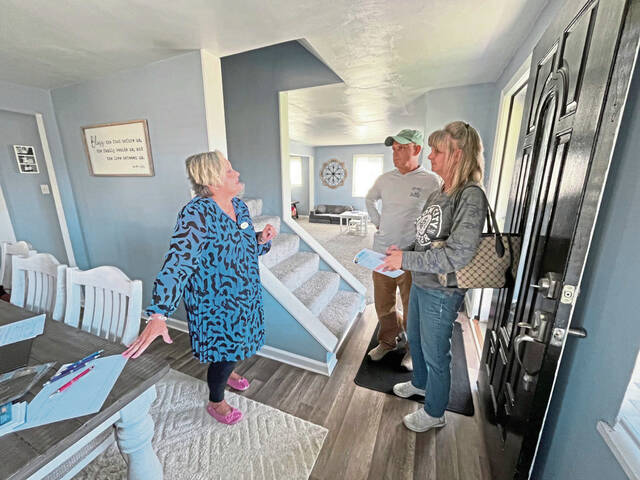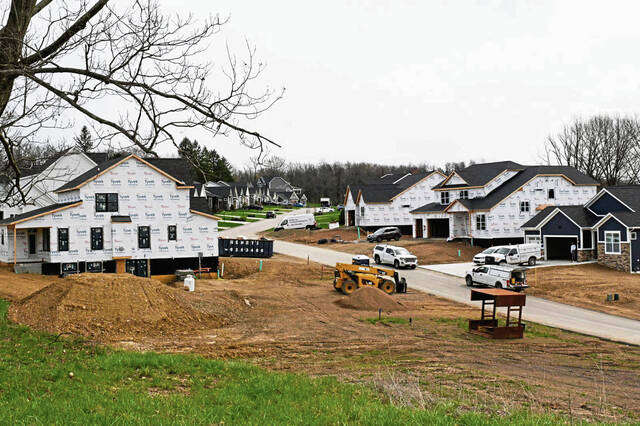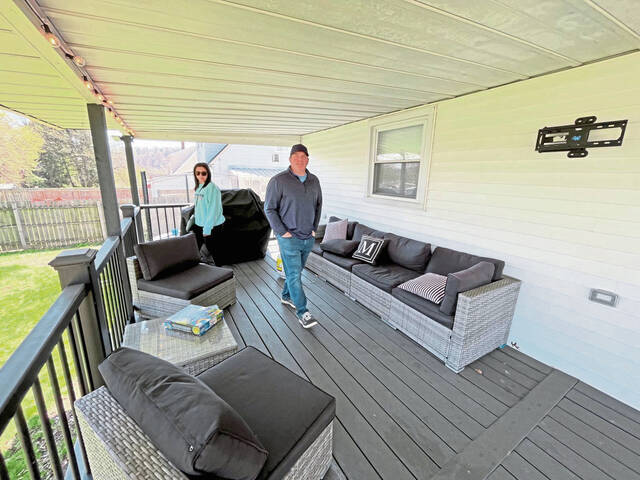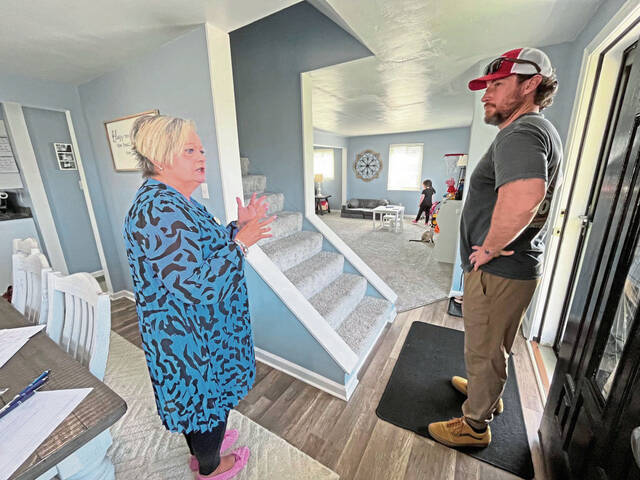Shortage of area homes, rising prices, interest rates fuel frustration for would-be buyers
House hunters such as Bruce and Brenda Babich are up against a perfect storm of low inventory, rising home costs and unfriendly mortgage rates.
That’s becoming the norm in the Pittsburgh housing market, which historically has been viewed as affordable.
“They’re not staying on the market long,” said Bruce Babich, 61, of Apollo.
He and Brenda are hoping to upgrade to a slightly larger home anywhere in Westmoreland, Armstrong or Indiana counties. Their budget: up to $250,000.
Yet they’re struggling to find a fit, having seen about 35 homes already this year.
“Either they’re overpriced and they sit there forever, or, if they’re a decent price, they’re going right away,” he said. “Demand has definitely pushed up the market.”
It’s a seller’s market.
Statewide, there are about 37,000 homes on the market, compared with an average of 59,000 at any given time in 2020, according to Kim Shindle, vice president of communications for the Pennsylvania Association of Realtors. That’s down 37% over the past five years, part of a broader inventory shortage nationally of about 5 million homes, said Sylvia Maxwell, president of the Greater Allegheny-Kiski Area Board of Realtors.
The shortage is particularly noticeable among homes priced at $150,000 or less, Maxwell said.
“There are a lot of first-time homebuyers who are looking to get into those homes,” she said. “With a $400,000 home, you might have a larger selection.”
Tony Molnar-Strejcek, a former manager with Howard Hanna Real Estate in Greensburg, is president of the Realtors Association of Westmoreland, Indiana and Mon Valley.
He said his chapter’s region actually has experienced an increase in available homes — 488 properties so far this year, compared with 390 during the same period last year. Still, he said, it’s not enough to satisfy the demand.
“The months-of-inventory (metric) tells us how long homes are sitting on the market,” he said. “This year to date, we’re up to 2.5 months of (home) inventory. Last year, it was 2.1 months of inventory.
“Those are still really low numbers. That’s not even a healthy market for buyers. Once you see it up around four months or higher, it becomes more of a neutral market.
“We’re still experiencing a low inventory. We desperately need more homes on the market. We’ve been dealing with low inventory for several years.”
Rising home costs
As inventory has shrunk, home prices have steadily risen, squeezing home buyers even more.
Median home prices rose 45% in Allegheny and Armstrong counties from 2019 to 2024 and went up about 41% in Butler County and 34% in Westmoreland County during that span, according to data from the National Association of Realtors.
It has become a frustrating reality for couples such as Alexandra and Jared Bowman of North Huntingdon.
Bowman, her husband and their three sons moved in with her parents five years ago. They are looking for a home in the township so she can remain near her family, whom she’ll rely on when her husband is deployed with the Army.
But the Bowmans are finding their house hunt defeating.
“When we moved home from North Carolina, it was in the middle of the pandemic and I was pregnant with my first son,” said Alexandra, 36. “The real estate market was crazy then. Because the interest rates were so low, you had a lot of eager buyers in the market who were willing to overspend and bypass the inspections. We assumed we’d wait until the market settled.
“The market has changed, but it really hasn’t settled.”
Now that the couple have three young boys under 5, they are eager to settle into their own home. But Bowman noted interest rates have increased, the inventory in their $200,000 to $600,000 price range isn’t large and, she said, “They’re still overpriced.”
With the overall economic picture uncertain, she said, “I’m trying to justify paying a certain price when I know these homes aren’t worth what they’re priced at.
“Now we’re kind of in this window of: Should we buy a house and renovate; should we buy a lot and build; or should we buy a newly built house? There are just so many what-ifs, and you don’t know what’s coming down the line.”
For the Babiches, even when they find an affordable possibility, it gets scarfed up quickly.
He said he and his wife had just made arrangements to check out a home priced at $190,000 when their Realtor told them someone else had snatched it up.
After the Babiches were married in June, Bruce moved into Brenda’s home and sold for $180,000 the home he had bought for $125,000 in 2012 in Washington County’s Fallowfield Township.
“Now a house like that is going for $225,000 to $250,000,” he said.
Though Babich and his wife are using a Realtor to help in their search for a new home, he sold his former home directly to the friend of a neighbor for what he considered a fair price.
Rising interest rates
The increase of mortgage interest rates from several years ago is an added factor in inhibiting home sales, from the perspectives of buyers and sellers.
“It’s kind of a domino effect,” said Shindle of the state Realtors association. “If people are staying longer in their homes, some may have got a 3% mortgage rate and many are reluctant to give that up to move to a higher-end home. That’s the challenging part of getting the capacity for first-time homebuyers.”
As of Monday, the average 30-year fixed mortgage rate was 7.07%, according to Investopedia.
“If your mortgage rate is lower, the more you have to shop with and you can get more of a home,” said Maxwell.
But, she added, “If the rates do go down, sometimes you will see more active buyers out there, which can sometimes affect the (home) supply. When you get a shortage, that increases the market value of your home.
“If the mortgage rates go up, the market value would go down. There would be more supply, but you would have less to shop with.”
Brent Ambrose, professor of real estate in Penn State’s Smeal College of Business, explained mortgage rates typically move in the same direction as interest rates on 10-year U.S. Treasury bonds.
With the uncertainty about the economy and tariffs, he said, “Investors around the world are looking at Treasury bonds and thinking maybe they’re not the safe asset they were. People are pulling money out of the bond market and investing in other things. That’s caused bond prices to go down and interest rates to start going up.”
Ambrose said he doesn’t see mortgage rates going lower any time soon.
“I wouldn’t be surprised if they sat where they are,” he said, but added, “There’s just way too much uncertainty in the world right now.
“If we sink into a recession, all bets are off.”
Maxwell agreed the next direction the home market will take is hard to foresee, given the uncertainty in the economic landscape. Some builders might be scaling back their plans for new home construction, she said, which isn’t a good sign for alleviating the inventory shortage.
“It’s just very unpredictable,” she said. “I think we’re all at a wait-and-see point right now.”
“It would be nice to see more homes at more affordable price points.”
Homebuyers get a better deal than renters in Pittsburgh
It might cost more to buy a Pittsburgh-area home in today’s market than in past years, but it can cost even more to rent one.
According to Realtor.com, the median monthly rent for a home in Pittsburgh in January was $1,413, compared with a median monthly mortgage payment of $1,199 for purchasing a $239,950 home there. Zillow.com placed the average Pittsburgh rental rate at $1,499 as of the end of March and the median home sale price at $221,000 at the end of February.
Ryan Scialabba is well versed in buying and renting homes. He’s one of two friends who in 2015 founded HomeBuyers of Pittsburgh, a real estate agency that specializes in buying homes in as-is condition and improving them either to flip or to operate as rental properties.
Scialabba said he’s seen more inexperienced investors become attracted by the local home market since the covid-19 pandemic, and he said many have ended up overpaying for properties without taking into account the full costs involved in renovating or maintaining them.
He counts himself among those who are “kind of sitting on the sidelines and taking on the opportunities that make sense. If you’re an investor and you’re flipping a house, you’ve got to make sure it’s done right and still price it aggressively.
“I’m looking for the sweet spot. There’s less opportunity than in years past, but it’s still there.”
Before the pandemic, Scialabba said, he could renovate a home for a cost of about $50 per square foot. Now, he said, with labor and material costs on the rise, he might have to pay between $75 and $89 per square foot.
The prices local homes will command haven’t risen to the same degree, he said, noting, “That’s where you’re getting squeezed.”
“We just did go through a phase where corporations were coming in and purchasing a lot of (home) properties in Westmoreland and Allegheny counties and turning them over for rental,” said Tony Molnar-Strejcek, president of the Realtors Association of Westmoreland, Indiana and Mon Valley. ”I believe they will eventually go back to single-family ownership.”
“We keep a lot more properties than we sell,” Scialabba said.
Homes he can purchase for under $200,000 tend to get more long-term attention and become rentals. He said he makes more basic renovations to higher-priced homes that he expects to flip within a year.
Currently, he said, there are fewer homes at the lower end of the price spectrum that are also in nicer condition.
“If it has good bones but hasn’t been updated, that will fly these days,” he said. “The first-time homebuyer will buy it and make updates as they go on.”
Jeff Himler is a TribLive reporter covering Greater Latrobe, Ligonier Valley, Mt. Pleasant Area and Derry Area school districts and their communities. He also reports on transportation issues. A journalist for more than three decades, he enjoys delving into local history. He can be reached at jhimler@triblive.com.
Remove the ads from your TribLIVE reading experience but still support the journalists who create the content with TribLIVE Ad-Free.






